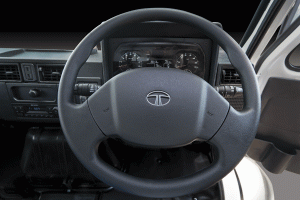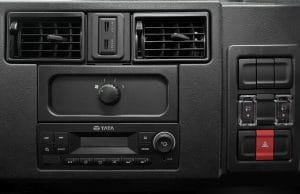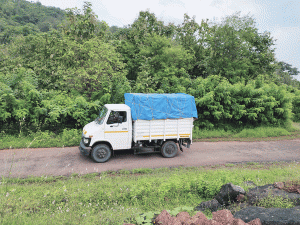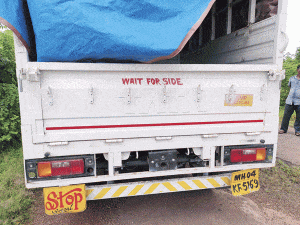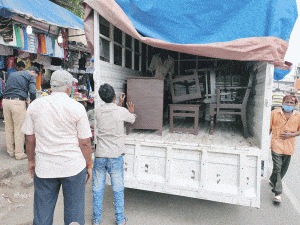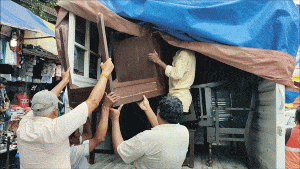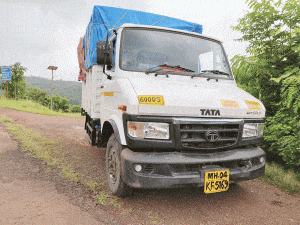
The Tata 407 SFC Gold BSVI is a curious mix of ‘history in motion’ and still very relevant and empowered.
Story by Bhushan Mhapralkar
It is late evening and the road past Pen on the famous Mumbai-Goa national highways turns terrible. It becomes difficult to pick up the road from the potholes as the bright headlamp beams break the monotony of the dark. Progress, albeit at a slower pace, is assured by a reliable machine that the Tata 407 SFC Gold BSVI is turning out to be. It is taking what is thrown at it with a compliant. Moving cargo from Vasai on the outskirts of Mumbai to Dapoli, some 280 kms to the south, the LCV, in its new, BSVI avatar, is coming across as a capable machine that is still very much relevant. Against the backdrop of much modernisation that is sweeping through the CV industry for a decade or two now, the Tata 407 SFC Gold BSVI is making a case of how its semi-forward cabin is still keeping up with the times. Coming to life in the mid-80s when the tide of modernisation was sweeping through the various tiers of the Indian auto industry, starting with the arrival of Government-backed Maruti Udyog on the scene, the Tata 407 did not take time to carve out a niche for itself. It was not an easy task with the likes of DCM Toyota, Eicher Mitsubishi and Swaraj Mazda on the scene.

Rolling off the Tata Motor’s modern facility built inside a vast plant at Pune, the Tata 407 drew many who found its semi-forward stance similar to that of a light truck by a German manufacturer. At a time when trucks were mostly offered as a rolling chassis, the Tata 407 offered a strong, fully-built cabin. Its efficient diesel engine changed the equation in terms of who trucks were perceived then. Much water has flown under the bridge, and the 2020 model with a 100 hp, three-litre BSVI diesel engine mated to a five-speed manual gearbox is turning out to be quite in tune with the times. The maximum torque has gone up from 250 Nm to 300 Nm. Work has also gone into making it more reliable and dependable as it gets up to the BSVI level. Seeing improvement on the NVH front too, with the use of new engine mounts that ensure no vibrations pass through, the use of better insulation material has also led to a cabin that is quieter and more comfortable.
Up to speed
Rolling down the Mumbai roads, and on the highway, what felt more intrusive was the road noise, wind noise and the noise of the vehicles passing by. Turning out to be comfortable to drive despite some very trying and congested roads, the 407 SFC Gold BSVI made a good impression for a machine that could trace its roots to a good decades ago. If the exterior changes like the new fascia bring the LCV up to speed with what is being offered currently, including the Tata Motors’ own thoroughly new breed Ultra range, this truck felt every bit worthy of application and usage. Fitted with parabolic leaf springs and double-acting shock absorbers at the front, and semi-elliptical multi leaf springs and double-acting shock absorbers at the rear, the 407 SFC Gold, with its re-positioned gearshift and pedals made for an easy drive. The improved low-end torque helped tackle differing road situations (the Kashedi ghat with its long hair pin sections put the LCV to a test) with confidence. If the higher seating position was immediately apparent, the large glass area contributed towards the airy feel of the cabin. Spacious the day cabin of the truck looked with the capability to accommodate three people, including the driver, in good comfort.
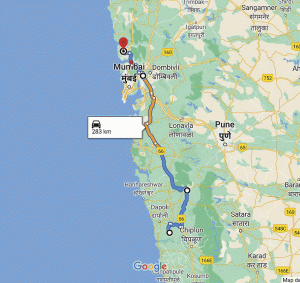
Behind the wheel, the modern dashboard and steering wheel made an early, positive impression. The dash texture gave the impression of it being hard wearing. Good for a truck and the abuse it could be subjected to. Featuring a lockable glovebox, a blower unit with a knob at the centre, the dashboard also incorporates a factory-fitted stereo, which is loud enough to make itself heard beyond the wind and road noise. The after-exhaust regeneration switches are located besides the steering column. They connect with the vehicle’s Selective Catalytic Regeneration (SCR) system. A proof in case is the urea dosing tank on the right side ahead of the rear wheel and adjacent to the 60-litre fuel tank. Tata Motors refers to the liquid as ‘DEF’. Witnessing a five-mm increase in thickness, the ‘C’-section ladder frame of the truck is now more robust according to Tata Motors’ sources. If the improved refinement levels were felt, the robustness of the truck was evident as it tackled the rain-ravaged sections of the Mumbai-Goa national highway.
Comfortable and convenient
The well-contained noise levels of the drivetrain adding to the improvement in the area of NVH, the Tata 407 SFC Gold BSVI, with its compact turning circle, made for easy driving as well as manoeuvring. If the truck seemed to shrink around its driver, the ORVMs providing a good view of the surrounding, what felt surprising is the seeming broad cargo tray that lapped up the cargo quite well. This particular model is available with a cargo deck length of 8.3 ft. A variant with 10 ft. deck length is on offer too, and adds to the versatility of the model range. Highly familiar and with a strong track record, the Tata 407 SFC Gold BSVI, through the 600 km drive, felt tough and robust. With a long legacy to talk home about, it also felt comfortable and convenient. With the cargo safely stacked in the HSD cabin, the truck, with a GVW of 4.4-tonnes and a payload of 2400 kg, made good progress throughout the journey. With speeds in the region of 60 to 65 kmph on the well-paved sections (the top speed is limited to 80 kmph), the LCV conveyed modernity through its digital instrument cluster with a certain ease. It was the bit of this truck that seem to impress time and again.
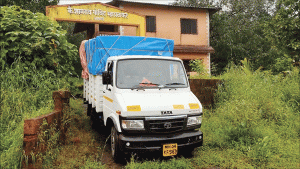
Incorporating a large tacho and speedometer, the digital instrument cluster is comprehensive. It conveys information about the health of the vehicle in the form of tell tale warning lamps that light up like a Christmas tree when the key is turned on and settle down to indicate the parameters. The LCD screen at the centre is interesting. A vertical bar graph indication speaks about the DEF level and at the top corner is the indication about average fuel efficiency. At the end of the journey, the LCV came to show a figure of 8.1 kmpl. A figure in the region of 7.8 kmpl was constant throughout the journey.
Aimed at diverse applications – this particular example does the duty of ferrying paint industry chemicals from the warehouse to bigger trucks at the terminal that takes it to various nooks and corners of the country, the Tata 407 SFC Gold BSVI, time and again, felt strong and dependable. It provided an insight into how trucks like it are being modernised to stay relevant and up to the speed. It surprised time and again with its agility and robustness. Perhaps the only model after the Tata 1210 to be so familiar and 407 light truck provided an insight into what Tata Motors refers to as the ‘Power of Six’. It is about greater profits, enhanced performance, increased driving comfort, greater convenience and connectivity, greater value, and improved safety and security.
The power of six
In terms of security and connectivity, the Tata 407 SFC Gold BSVI comes with a red SOS button on the dashboard. It is a button that the driver could use to send an SOS message to the transport owner in an emergency. It is a part of Tata Motors advanced telematics platform, the Fleetman. A versatile piece of modern gadgetry aboard a BSVI machine as standard, it helps to track and trace, to manage trips and maximise utilisation and to assess driver behaviour and vehicle health. Referred to as a truck range that is ‘The Non-Stop Profit Machine’, the Tata 407 SFC Gold BSVI, throughout the drive, provided an insight into why it has been so successful. Over 500,000 units of the Tata 407 have been sold till date. Said to have been born out an arrangement in 1986 when Tata Motors purchased all of the pressing tools for Steryr’s 591/691 series of trucks, the Tata 407 SFC Gold BSVI made a solid impression. Perhaps the only semi-forward control LCV that is claimed to be available in 4×4 configuration too, the truck, throughout the long journey, made for an interesting case. If it felt like history in motion, the light truck also reminded, time and again, about how it took on the competition to emerge as the most preferred LCV starting from the mid-80s. To sum up, the Tata 407 SFC Gold BSVI, put to a test, over the distance of 600 km of near non-stop driving except for loading and unloading of cargo, felt quite relevant and empowered yet.



